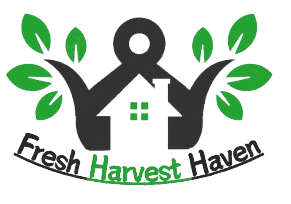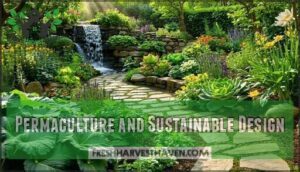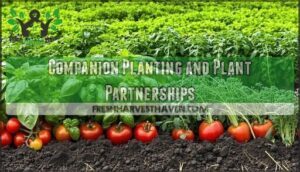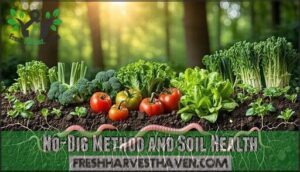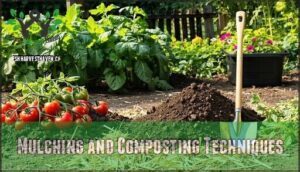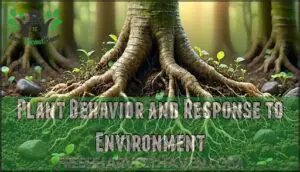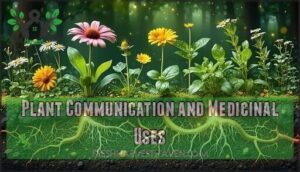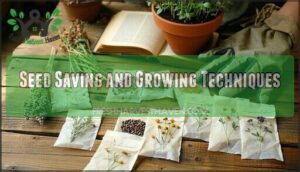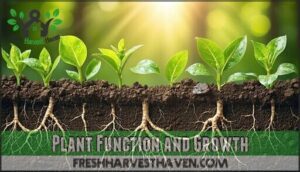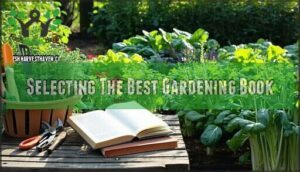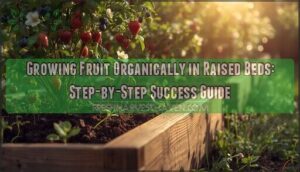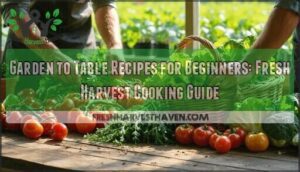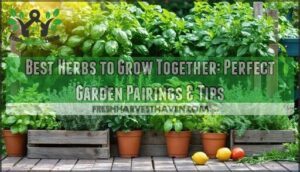This site is supported by our readers. We may earn a commission, at no cost to you, if you purchase through links.
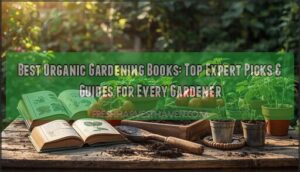 You’ll find the best organic gardening books combine scientific expertise with hands-on wisdom for sustainable growing.
You’ll find the best organic gardening books combine scientific expertise with hands-on wisdom for sustainable growing.
Top picks include Rodale’s Basic Organic Gardening for soil fundamentals, The Organic Gardening Encyclopedia for pest solutions, and The Vegetable Gardener’s Bible for crop rotation strategies.
These guides teach you to work with nature’s systems rather than fight them. They cover essential techniques like composting kitchen scraps, building healthy soil microbes, and creating beneficial insect habitats.
Whether you’re starting seeds or designing permaculture systems, the right book transforms complex concepts into actionable steps. The secret lies in understanding how soil health, plant communication, and natural cycles work together.
Table Of Contents
- Key Takeaways
- Organic Gardening Basics
- Top 9 Organic Gardening Books
- 1. Rodales Basic Organic Gardening Beginners Guide
- 2. Organic Gardening Encyclopedia Book Guide
- 3. Complete Guide to Flower Gardening
- 4. Perennial Garden Planting and Pruning Guide
- 5. Guide to Plants and Flowers
- 6. Natural Pest Control Gardening Handbook
- 7. Container Garden Fresh Ideas Book
- 8. Landscape Design Encyclopedia Planning Building Planting
- 9. Vegetable Gardening High Yield System
- Gardening Techniques and Methods
- Plant Health and Communication
- Selecting The Best Gardening Book
- Frequently Asked Questions (FAQs)
- What are the best organic gardening books?
- Which book is best for growing organic food?
- Is there any practical organic gardening advice?
- What is the essence of organic gardening?
- Are there any books about organic composting?
- What is a good book on non-toxic farming?
- What is the best gardening book of all time?
- What is the best gardening book for beginners?
- Is organic gardening worth it?
- What is the best organic matter to add to your garden?
- Conclusion
Key Takeaways
- Start with soil fundamentals – Master composting, soil health, and no-dig methods before diving into specific crops, as healthy soil is the foundation for successful organic gardening.
- Choose books that match your experience level – Beginners should start with "Rodale’s Basic Organic Gardening" while experienced gardeners can tackle specialized guides like "The Vegetable Gardener’s Bible."
- Look for practical, actionable advice – The best organic gardening books include step-by-step instructions, troubleshooting charts, seasonal calendars, and plant-specific care guides that you can implement immediately.
- Focus on books that teach natural systems – Select guides that explain companion planting, permaculture principles, and how plants communicate, so you will work with nature instead of fighting it.
Organic Gardening Basics
You’ll need to master soil health, composting, and seed starting to build a strong foundation for organic gardening.
These basics help you grow healthier plants and create a productive garden that’s safe for your family.
Soil Health and Composting
When building a vibrant garden, you’ve got to start from the ground up—literally.
Healthy organic soil relies on a rich mix of composted kitchen scraps, balanced microbe communities, and sturdy soil structure.
Composting isn’t just tossing scraps; it’s about fueling nutrient cycling and fine-tuning microbe balance for long-term soil health.
Try these strategies:
- Set up vermicomposting—red worms turn waste into organic matter
- Brew compost tea to feed soil microorganisms directly
- No-till gardening preserves soil structure and helps organic soil thrive
Mastering fall garden composting techniques can substantially improve soil fertility. Master these to reveal your garden’s full potential.
Seed Starting and Plant Care
After building healthy soil, your next step is mastering seed starting and plant care. The best organic gardening books offer practical advice for beginners and seasoned growers alike.
Start with smart Seed Selection, then watch your Germination Tips pay off by checking Soil Temperature before planting. Keep Water Management consistent—never let seedlings dry out or drown.
For strong roots, transplant when plants are sturdy. Use companion plants for pest prevention and prune wisely to boost Plant Nutrition. Rotate crops to outsmart pests and keep soil thriving.
Here’s your quick guide:
- Check soil temperature
- Water consistently
- Transplant strong seedlings
- Prevent pests organically
Top 9 Organic Gardening Books
You’ll find the top nine organic gardening books offer clear, practical advice for every skill level and garden size.
These expert guides help you build healthy soil, grow vibrant plants, and solve common gardening problems efficiently, which is crucial for a successful gardening experience with practical advice.
1. Rodales Basic Organic Gardening Beginners Guide
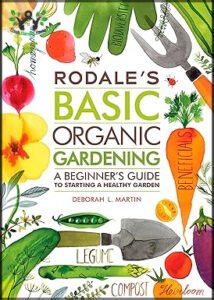
If you’re just dipping your toes into organic gardening, Rodales Basic Organic Gardening is the organic gardening guide you’ll want on your shelf.
This book is like a trusted friend—breaking down Soil Basics, Compost Tips, and Garden Planning into bite-sized lessons.
You’ll find over 100 gardening terms explained in plain language, so you won’t feel lost in a sea of jargon.
The Smart Starts sidebars offer hands-on projects perfect for beginners, while no-dig methods keep things simple and save your back.
The flower, vegetable, and herb finder helps you pick easy-care plants, steering you clear of common Beginner Mistakes.
With advice on Organic Tools and seasonal tasks, it’s one of the best gardening books for gardening for beginners.
Rodales Basic Organic Gardening makes learning feel manageable, setting you up for a thriving, organic garden.
2. Organic Gardening Encyclopedia Book Guide
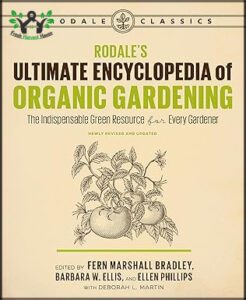
If you’re searching for a gardening encyclopedia that’s packed with practical advice, Rodale’s Ultimate Encyclopedia of Organic Gardening is your go-to organic gardening guide.
This book isn’t flashy, but it’s loaded with real-world solutions from gardeners who’ve been in the trenches. You’ll find everything organized alphabetically, so answers are easy to locate—whether you need tips on composting or insights on soil science.
It’s like having a wise neighbor who’s always ready with organic methods and gardening tips.
Here’s why gardeners keep this classic close:
- Trusted Book Reviews from decades of experts
- Straightforward Compost Guide for every climate
- Reliable advice on permaculture gardening and organic methods
- Practical solutions for pest control and plant care
- All-in-one reference for beginners and seasoned pros
If you want mastery over your garden, this encyclopedia helps you grow with confidence. Mastering soil preparation techniques is essential for a thriving garden ecosystem.
3. Complete Guide to Flower Gardening
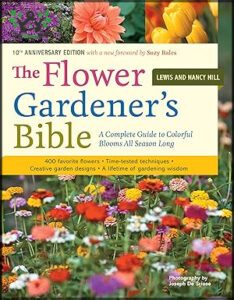
Ever wondered how to craft show-stopping Flower Arrangements and Garden Designs that truly pop? The Flower Gardener’s Bible is your go-to guide for mastering bloom care and petal health, blending practical Floral Tips with inspiration from real gardens.
You’ll get step-by-step advice on planning, planting, and maintaining vibrant flower beds, plus easy-to-use worksheets to track your progress. The Gallery of Gardens features country, traditional, and naturalistic styles, each with companion planting strategies for healthier blooms.
Explore 400+ flower profiles, complete with zone-specific care and permaculture gardening pointers. Whether you’re new to flower gardening or aiming for mastery, this book makes organic gardening books approachable and actionable.
Check out the table below for a quick overview:
| Feature | Benefit |
|---|---|
| Step-by-step guidance | Confident garden planning |
| Gallery of Gardens | Design inspiration |
| Flower profiles | Targeted bloom care |
| Companion planting tips | Healthier, resilient beds |
4. Perennial Garden Planting and Pruning Guide
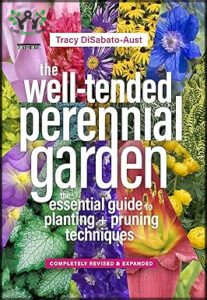
If you want to master Perennial Care and keep your garden blooming year after year, The Well-Tended Perennial Garden is your go-to guide.
Tracy DiSabato-Aust breaks down Garden Layout and Pruning Tips so you’re not left guessing.
You’ll find monthly schedules for Seasonal Maintenance, clear pruning techniques like deadheading and pinching, and practical advice for Plant Selection.
The Encyclopedia of Perennials section is a lifesaver, offering species-specific plant care and companion planting ideas.
With 36 organized plant lists, you can match your garden’s needs to your lifestyle.
Whether you’re just starting or refining your perennial garden, this book gives you the confidence to prune, plant, and plan with ease.
- Monthly planting schedules
- Pruning techniques explained
- Plant lists by maintenance
- Encyclopedia of Perennials
5. Guide to Plants and Flowers
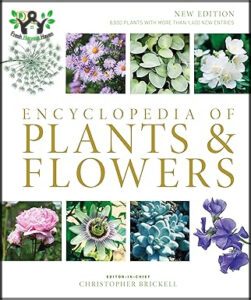
This exhaustive plant encyclopedia transforms your gardening journey with visual clarity and expert guidance.
You’ll discover 4,000 stunning plant and flower photographs that make Plant Identification effortless, whether you’re admiring perennials or planning your next Garden Design project.
The Plant Selector section acts as your personal consultant, matching plants to specific growing conditions like coastal environments or shade gardens.
This feature streamlines Flower Care decisions by connecting you with species that’ll thrive in your unique space.
Christopher Brickell leads 15+ horticultural experts in delivering detailed descriptions of over 8,000 varieties.
The 743-page resource includes 1,380 newly added plants, ensuring you’re working with current cultivars and proven performers.
Best For: Beginners building foundational knowledge, experienced gardeners seeking fresh inspiration, and anyone needing reliable plant encyclopedia guidance for successful organic gardening.
6. Natural Pest Control Gardening Handbook
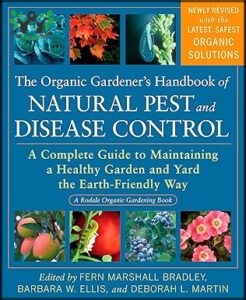
The Organic Gardener’s Handbook of Natural Pest and Disease Control becomes your trusted ally when unwanted insects and diseases threaten your garden’s success.
This extensive 907-page resource covers over 200 popular plants with detailed photographs for quick pest identification.
You’ll find science-based recommendations for maintaining healthy plants using eco-friendly methods instead of harsh chemicals.
The handbook organizes solutions by plant type, making it simple to locate specific guidance for your situation.
Key features that make this handbook essential:
- Complete insect encyclopedia – distinguishes beneficial insects from harmful garden pests
- Natural fungicides and organic pesticides – hundreds of chemical-free treatment options
- Soil remediation techniques – addresses underlying causes of plant stress and disease
- Natural insect control strategies – multiple approaches for every pest management challenge
Perfect for gardeners seeking reliable organic pest control and disease control methods that protect both plants and beneficial wildlife.
Best For: Organic gardeners wanting science-backed natural pest control solutions.
7. Container Garden Fresh Ideas Book
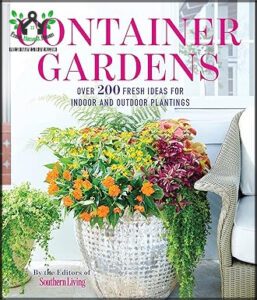
Transforming cramped quarters into thriving green spaces requires creativity and smart planning.
This thorough guide delivers practical solutions for maximizing small space gardening potential through innovative container designs.
The book features over 25 step-by-step projects specifically designed for urban gardening enthusiasts.
You’ll discover container gardening tips that work for balconies, patios, and windowsills.
Each project includes detailed instructions and vibrant photography to guide your garden designs.
| Container Type | Best Plants | Space Required |
|---|---|---|
| Window Boxes | Herbs, lettuce, flowers | 2-3 feet width |
| Hanging Baskets | Trailing plants, strawberries | Vertical space |
| Large Planters | Tomatoes, peppers, shrubs | 3+ square feet |
| Tabletop Pots | Succulents, small herbs | 6-12 inches |
The book’s "container recipes" eliminate guesswork by providing proven plant combinations.
Fresh ideas include vertical gardening systems and seasonal displays that maximize harvest potential.
Best For: Urban gardeners seeking creative container gardening solutions and practical advice for transforming limited spaces into productive gardens.
8. Landscape Design Encyclopedia Planning Building Planting
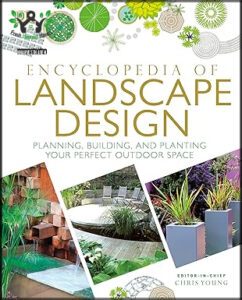
Mastering landscape design transforms your outdoor space from ordinary to extraordinary. The Encyclopedia of Landscape Design guides you through thorough garden planning and spatial design fundamentals that create stunning, eco friendly environments.
This hardcover resource covers essential landscape planning techniques, from initial site assessment to final plant placement strategies. You’ll explore diverse garden styles including modern and Japanese designs, learning practical skills like patio installation, pond creation, and drainage management.
The book excels in three key areas:
- Garden Layout principles that maximize space efficiency and visual appeal
- Permaculture design concepts that promote sustainable gardening practices
- Visual plant directories with detailed placement recommendations for ideal growth.
Featuring 16 award-winning case studies, this thorough guide demonstrates real-world applications of landscape design theory. Whether you’re a beginner seeking foundational knowledge or an experienced gardener refining your skills, the encyclopedia transforms complex design concepts into achievable projects.
Best For: Homeowners, landscaping professionals, and gardeners seeking practical guidance for creating beautiful, sustainable outdoor spaces through proven organic gardening books methodology.
9. Vegetable Gardening High Yield System
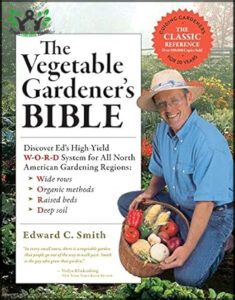
Your vegetable garden can become a high yield powerhouse with the right system and techniques.
The Vegetable Gardener’s Bible by Ed Smith delivers proven methods for maximizing harvests through wide-row planting and raised beds.
You’ll master crop rotation strategies that maintain soil fertility while preventing pest buildup.
Smith’s deep soil preparation techniques create the foundation for exceptional vegetable selection and growth.
The book covers essential gardening tools and spacing methods that boost productivity in any size plot.
You’ll learn permaculture design principles that work alongside organic gardening practices.
High yield techniques include companion planting charts and seasonal planning guides that eliminate guesswork.
Smith’s approach combines traditional wisdom with modern organic gardening methods.
The detailed vegetable profiles help you choose varieties suited to your climate and space.
Visual aids and planting schedules make garden planning straightforward, whether you’re working with containers or acres.
Best For: Gardeners seeking maximum harvests using organic methods in raised beds or traditional plots.
Gardening Techniques and Methods
You’ll discover proven gardening techniques that work with nature instead of against it, creating healthier plants and soil.
These methods focus on sustainable practices that reduce your workload while maximizing your garden’s productivity and environmental benefits.
Permaculture and Sustainable Design
Permaculture creates self-sustaining gardens that mimic nature’s patterns while reducing your workload by 80%.
Sustainable design principles from organic gardening books like Gaia’s Garden teach regenerative design methods that build ecological balance. You’ll learn zoning techniques that place frequently harvested plants near your home and establish sustainable landscapes using native species.
These environmental systems integrate water catchment, composting, and green architecture concepts. Sustainable agriculture approaches stack functions—trees providing food, shade, and wildlife habitat simultaneously.
Your garden becomes a thriving eco friendly ecosystem requiring minimal external inputs. By studying organic gardening techniques, gardeners can create more efficient and productive spaces.
Companion Planting and Plant Partnerships
Smart gardeners know that companion planting transforms scattered plants into powerful plant allies. These strategic plant partnerships create natural pest control while boosting crop diversity.
Your garden achieves soil harmony through garden symbiosis when you match compatible species.
Organic gardening books featuring permaculture principles recommend these winning combinations for enhanced biodiversity:
- Tomatoes with basil – repels aphids and improves flavor
- Corn, beans, and squash – maximizes nutrients and space
- Carrots with chives – deters carrot flies naturally
No-Dig Method and Soil Health
While companion planting creates strategic partnerships between plants, the no-dig method revolutionizes how you work with soil.
You’ll layer organic amendments like compost directly onto beds without disturbing the soil structure underneath.
| No-Dig Benefits | Traditional Digging | Results |
|---|---|---|
| Preserves soil layers | Disrupts soil structure | Better water retention |
| Encourages worm composting | Kills beneficial organisms | Natural carbon sequestration |
| Reduces weeding time | Creates weed problems | Healthier plant growth |
This nodig gardening approach maintains mycorrhizal networks that feed plants naturally.
Your soil health improves as earthworms aerate beds while you avoid back-breaking labor.
By adopting a regenerative approach, gardeners can enhance soil fertility and overall ecosystem balance.
Mulching and Composting Techniques
Most gardeners underestimate how mulching and composting transform ordinary soil into thriving ecosystems. These fundamental techniques create sustainable nutrient cycling while reducing waste and maintenance.
Mulch types like straw, leaves, and wood chips offer different decomposition rates and benefits. Organic compost feeds beneficial microorganisms that enhance plant health. Understanding these soil amendments helps you build carbon sequestration naturally.
Master these three proven methods:
- Start worm composting with red worms for faster nutrient-rich results
- Apply organic mulch 2-3 inches thick for ideal moisture retention
- Brew compost tea weekly using your composting guide to supercharge plant growth
These techniques work together, creating self-sustaining gardens that practically manage themselves. Effective use of organic mulch materials is vital for maintaining healthy soil ecosystems.
Plant Health and Communication
Understanding how plants respond to their environment transforms you from a basic gardener into someone who works with nature’s intelligence.
You’ll discover how plants communicate through chemical signals, adapt to stress, and form partnerships that can revolutionize your organic growing success.
Plant Behavior and Response to Environment
Plants act like sophisticated biological computers, constantly monitoring their environment and adjusting through hormone regulation. When you understand plant hormones like auxin and gibberellin, you’ll see how they control root development and stem growth in response to light changes.
Environmental adaptation happens through remarkable stress response mechanisms. Heat triggers over 200 protective proteins, while drought causes stomatal closure, reducing water loss by 35%. Photosynthesis rates shift based on light intensity, optimizing energy production.
Soil microbes form partnerships through mycorrhizal networks, creating underground communication highways. These fungal connections boost phosphorus uptake by 30%, enhancing plant growth substantially.
Plant communication occurs through chemical signals – damaged leaves release compounds that warn neighbors of threats, increasing pest resistance by 38% in nearby plants.
photosynthesis timing
Plant Communication and Medicinal Uses
Your garden’s underground mycorrhizal networks create nature’s internet, letting plants share plant signals about dangers and resources.
Medicinal herbs like echinacea and calendula produce healing medicinal compounds when grown organically.
Books such as The Secret Life of Plants and The Lost Language of Plants explore ethnobotany and hormone regulation.
These networks enhance your herbal remedies’ potency naturally.
Seed Saving and Growing Techniques
Building on plant communication insights, seed saving becomes your gateway to gardening independence and genetic preservation.
You’ll master techniques that connect you directly to centuries-old agricultural wisdom.
Proper seed selection from your healthiest plants creates stronger future generations.
Germination methods using damp paper towels test seed viability before planting season arrives.
Seed storage in cool, dry containers protects heirloom varieties from moisture and pests.
Organic gardening books teach these time-tested seed starting approaches that reduce dependence on commercial suppliers.
Plant breeding knowledge helps you develop varieties suited to your specific growing conditions.
Crop rotation planning guarantees saved seeds maintain genetic diversity year after year.
Each saved seed represents independence and resilience passed down through generations.
Watching your saved seeds sprout feels like witnessing small miracles unfold.
- Seed selection from your strongest plants guarantees better genetics
- Proper germination methods reveal which seeds will actually grow
- Cool, dry seed storage preserves viability for multiple seasons
- Heirloom varieties tell stories of resilience through centuries
- Building seed libraries strengthens entire gardening communities
Effective garden management involves understanding crop rotation techniques to optimize soil health and plant productivity.
Plant Function and Growth
Understanding photosynthesis reveals the secret to thriving plants in your garden.
This cellular powerhouse converts sunlight into energy while root development creates networks for nutrient absorption.
Hormone regulation acts like your plant’s control center, directing cell growth and flowering cycles.
Plant nutrition depends on balanced soil conditions and organic fertilizers that support natural processes.
Quality composting creates the foundation for excellent soil health, while understanding these mechanisms helps you choose the right organic gardening books.
| Plant Process | Garden Impact | Your Action |
|---|---|---|
| Photosynthesis | Energy production | Provide adequate sunlight |
| Root Development | Nutrient uptake | Improve soil structure |
| Hormone Regulation | Growth control | Provide balanced nutrition |
Mastering plant health starts with recognizing these interconnected systems working together in your garden ecosystem.
Selecting The Best Gardening Book
With countless organic gardening books on the market, you’ll want to select one that matches your experience level and specific growing goals.
The right book should offer clear, actionable advice that you can immediately apply to your garden, whether you’re starting your first compost pile or perfecting advanced permaculture techniques.
Choosing The Right Book for Your Needs
Success starts with matching best gardening books to your specific goals and experience.
Book reviews reveal which gardening resources suit different skill levels and gardening styles. Consider your personal interests—vegetables, flowers, or permaculture—along with budget constraints.
Reading preferences matter: digital garden books offer searchability while physical copies work outdoors. Check author credentials and publication updates.
Beginner resources focus on basics, while advanced organic gardening books explore specialized techniques. Align your choice with garden size and objectives for maximum value.
Understanding organic gardening methods is essential for creating a thriving and sustainable garden ecosystem.
Considering Your Gardening Experience Level
Gardening Levels determine which best gardening books suit your journey.
Beginner Tips start with beginnerfriendly titles like "Rodale’s Basic Organic Gardening" covering soil fundamentals.
Experienced Insights come through intermediate techniques in "The Well-Tended Perennial Garden."
Advanced methods await in specialized texts like "Teaming with Microbes."
Your Learning Curve accelerates when you match organic gardening books to your current abilities.
Skill Assessment prevents overwhelming yourself while ensuring steady growth toward mastery.
Looking for Books With Practical Advice and Tips
Once you’ve matched your skill level with the right gardening guides, you’ll want books packed with practical advice that actually works. The best organic gardening books skip theory and deliver gardening tips you can implement immediately.
Quality book reviews consistently highlight guides featuring troubleshooting charts, seasonal calendars, and plant-specific care instructions. Beginner-friendly titles excel when they include step-by-step photography and clear problem-solving sections.
Look for organic methods books that provide:
- Regional planting calendars suited to your climate zone
- Detailed pest identification charts with natural solutions
- Plant spacing diagrams with exact measurements and companion suggestions
The most valuable gardening guides transform overwhelming concepts into manageable weekend projects.
Frequently Asked Questions (FAQs)
What are the best organic gardening books?
Over 60% of gardeners report better yields when they master organic techniques through expert-written guides.
You’ll want "The Vegetable Gardener’s Bible" for thorough growing methods and "Rodale’s Basic Organic Gardening" for foundational knowledge that builds lasting skills.
Which book is best for growing organic food?
The Gardener’s A-Z Guide to Growing Organic Food stands out as your best choice for thorough organic food cultivation.
It’s organized by plant type, making it incredibly easy to reference specific growing techniques and storage methods for each crop you want to grow.
Is there any practical organic gardening advice?
You’d think after decades of chemical farming we’d know better, but here’s the secret: start with compost-rich soil, plant companions like tomatoes with basil, and mulch everything heavily.
What is the essence of organic gardening?
Organic gardening nurtures your soil naturally through composting, avoids synthetic chemicals, and creates sustainable ecosystems.
You’ll grow healthier food while supporting beneficial insects, earthworms, and microorganisms that keep plants thriving long-term.
Are there any books about organic composting?
Yes, several excellent books focus specifically on organic composting.
"Let It Rot!" by Stu Campbell is a foundational composting text with practical techniques for creating nutrient-rich compost to build healthy soil naturally.
What is a good book on non-toxic farming?
The Organic Gardener’s Handbook of Natural Insect and Disease Control" offers thorough non-toxic farming methods. You’ll master organic pest management without harmful chemicals, protecting your soil and crops naturally.
What is the best gardening book of all time?
The Vegetable Gardener’s Bible" consistently ranks as the top gardening book of all time.
You’ll find thorough growing techniques, soil management, and practical advice that transforms any garden into a productive paradise.
What is the best gardening book for beginners?
Looking for the perfect starter guide to transform your gardening dreams into reality?
Rodale’s Basic Organic Gardening stands out as the ideal beginner’s book, covering essential soil basics, plant care fundamentals, and maintenance techniques you’ll actually use.
Is organic gardening worth it?
You’ll build healthier soil, grow safer food, and create long-term ecosystem benefits. It’s absolutely worth investing in organic methods for sustainable gardening success.
What is the best organic matter to add to your garden?
Compost, aged manure, and leaf mold are your best organic matter choices. They’ll feed soil microbes, improve drainage, and boost nutrient availability for stronger plants.
Conclusion
Choosing from these best organic gardening books plants the seeds for a thriving, sustainable garden.
Whether you’re mastering soil health basics or exploring advanced permaculture techniques, these guides transform complex natural systems into simple, actionable steps.
Your perfect match depends on your experience level and specific goals—from container gardening to large-scale food production.
Start with one thorough guide, then expand your library as your garden grows, focusing on complete concepts and using them to achieve sustainable garden success.
